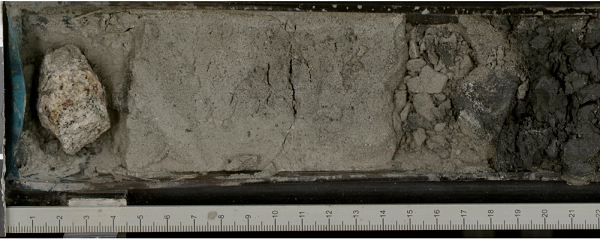Tracking past growth and collapse of the Antarctic ice sheet

Ice-rafted granitic dropstone in Miocene marine sediment core, Weddell Sea. Photo credit: IODP/Michelle Penkrot
Summary
The Antarctic ice-sheet (AIS), since the time of its major expansion into a permanent ice sheet during the Late Eocene - Early Oligocene, has experienced a dynamic history of alternating retreat-expansion cycles in response to global climate variation (and on geological timescales, changes in underlying topography). This variability was especially pronounced during the Miocene, as documented globally by a wealth of indirect evidence from geochemical, isotopic, and sedimentological proxies (e.g., δ18O fluctuations), as well as limited direct evidence from drill cores recovered from ice-sheet marginal sediments. These data have been used to argue for a major retreat in the size of the AIS as a response to the Mid-Miocene Climate Optimum, characterised by a peak in global temperatures and a rise in sea level, followed by a major Antarctic ice-sheet expansion and stabilisation during the Mid-Miocene Climate Transition (MMCT), characterised by rapid cooling of ca. 6-7 °C in the high-latitude Southern Ocean between ca. 14.2 to 13.8 Ma.
Antarctic ice-sheet instability during the MMCT is recorded by ice-rafted debris in numerous horizons of marine sediment cores obtained around the Antarctic margin. This rafted debris reflects iceberg calving during times of ice-sheet instability. The objective of this project is to determine the location of iceberg calving sites, particularly around the Weddell Sea, in order to identify ice-sheet sectors characterised by repeated instability. These data can be used to evaluate reconstructions from the latest generation of paleo-ice sheet models, which in turn can be used to predict future ice-sheet responses to anthropogenic climate change.
To trace the onshore source(s) of ice-rafted debris, a range of detrital provenance techniques are employed, including U-Pb and trace-element analysis of accessory minerals (apatite, rutile, zircon), and in-situ Rb-Sr and Pb-isotope analysis of rock forming phases (K-feldspar, plagioclase). These are applied to offshore marine sediment cores, mostly collected as part of the International Ocean Discovery Program (and predecessor programs).
This research is funded by Science Foundation Ireland (grant number 18/SIRG/5559).
Project participants at the museum
External project participants
- J. Stephen Daly
 (co-investigator), University College Dublin, Ireland
(co-investigator), University College Dublin, Ireland - Roland Neofitu
 (PhD student), University College Dublin, Ireland
(PhD student), University College Dublin, Ireland


